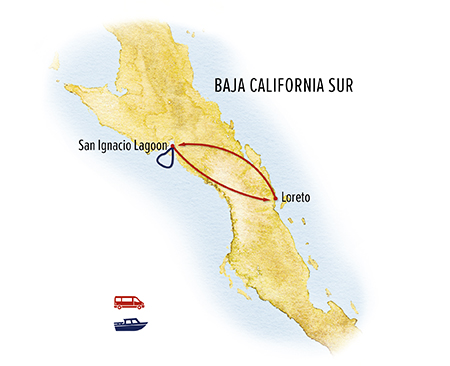Itinerary
Our whale-watching tour begins upon arrival in the small coastal town of Loreto on the Sea of Cortez. A Nat Hab representative meets you at the airport and joins you on the short transfer to our waterfront hotel where our Expedition Leader will be waiting to greet you. Loreto was founded as a Spanish mission by Jesuit priests in 1697 and is the oldest permanent settlement on the Baja Peninsula. Loreto offers fine beaches, reef snorkeling, nearby islands to discover, and excellent hiking in the Sierra de la Giganta Mountains that rise behind the peaceful town centered on a colonial Spanish plaza. This evening, gather for a welcome dinner and a preview of our time with the magnificent gray whales of Baja.
Day 2: Loreto / San Ignacio Lagoon
A scenic drive is in store as we traverse the mountainous spine of narrow Baja California Sur to reach the Pacific Ocean. First, we follow the Sea of Cortez coastline northward, then turn west into a dramatic landscape of arid mountains and giant cardon cacti. Once we reach the sleepy colonial village of San Ignacio, we transfer into smaller vans for the remainder of the trip to the coast, arriving at our whale camp in the afternoon. Then, time permitting, we'll set out on our first whale-watching excursion. Our accommodations on San Ignacio Lagoon—private for Nat Hab guests only—are a special feature of our trip. Secluded on a quiet stretch of rocky beach, the cabanas are well-built thatched structures, rustic but inviting, each with two beds and a window overlooking the bay. Ecological shower facilities and toilets are shared, though an en suite room equipped with a small hygienic porta-potty is provided for nighttime relief. These remote lodgings are basic and cozy, offering the opportunity to experience the wilderness of the Vizcaino Desert, a 6-million-acre UNESCO Biosphere Reserve, in solitude and comfort. We are also secluded in a remote area under very dark skies, making for outstanding star viewing.
Days 3 & 4: Whale Watching & Exploring El Vizcaino Biosphere Reserve

Whales have been revered as mystical creatures by many cultures, and an intimate encounter with them is a dream realized for wildlife lovers. Pacific gray whales make the world's longest mammal migration, traveling 10,00-12,000 miles annually between their summer feeding grounds in the cold Arctic waters of Alaska's Bering Sea to reach their sheltered winter calving lagoons in Baja, then swimming north again in the spring. Our Expedition Leader and local guides provide expert interpretation about the whales' remarkable journey and their fascinating range of behaviors, which we expect to witness at close range.
We make multiple whale-watching excursions in San Ignacio Lagoon in motorized open pangas, offering an unimpeded view. We may see whales breach, spy-hop or glide up close to present their backs for a scratch. Generally, we spend 90 minutes whale-watching on each excursion and make two excursions per day (due to conservation regulations, these numbers may vary, depending on the total number of boats on the water at a given time), with a total of six whale-watching outings during our stay. Numerous whales enter this particular lagoon, and our maneuverable small boats allow us to get incredibly close. Naturally, we are very sensitive to the animals’ demeanor, and our panga captains are experts at positioning the boats to maximize proximity to the whales without disturbing or encroaching upon them, instead allowing them to approach us—which they often do. We may see males competing for females, young adults playing, and mothers protecting and teaching their calves, perhaps the most endearing of all our encounters. Calves are 14-16 feet at birth and gain 50 pounds a day as they grow, and some swim within arm’s length of our boats. Once a gray whale reaches full maturity, it will weigh 30-40 tons and reach 50-60 feet long.
Ashore, we visit the nearby fishing village and learn about the history and culture of the people who live around San Ignacio Lagoon. We view a mural of Pachico Mayoral, a local fisherman remembered as the first person to have a friendly encounter with a gray whale in the lagoon in 1972, changing the community’s relationship with them. After commercial whaling was banned in Mexico in 1947, fishermen still saw whales as adversaries, threatening their catch. But Mayoral's remarkable encounter—when a huge whale surfaced alongside his boat and rubbed against his outstretched hand—inspired him to offer whale-watching tours, opening the door to ecotourism that today provides incentive to local people to advocate for the whales' protection. Depending on the day, we may also tour a local oyster farm, with a chance to sample fresh oysters. Other activities around the lagoon include birdwatching, exploring the vast, empty beaches looking for bones and shells, surveying the expansive salt flats around the lagoon as we drive beyond camp, and if weather and tides cooperate, we might investigate the local mangrove estuaries.
Day 5: Whale Watching / Loreto
After a last chance to spend time with the whales, it's time to drive back to San Ignacio. At the picturesque main plaza, we stop to eat our packed lunches and explore some of the history of this colonial town founded as a Jesuit mission in 1728. During a bit of free time, view the monastery, sample local coffee or authentic tacos from one of the many stands in and around the square, or shop for locally made souvenirs. Then it's time to cross the Sierra de la Giganta Mountains once more to return to Loreto. We gather for a farewell dinner and a final evening together in this laid-back coastal town.
Day 6: Loreto / Depart
Our whale-watching adventure comes to a close with a transfer to the airport for flights home. Or, choose to spend an extra day in Loreto to explore its well-preserved colonial architecture and heritage in this little-developed region on the Sea of Cortez.



























